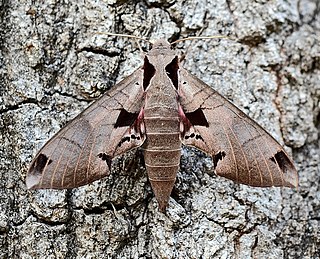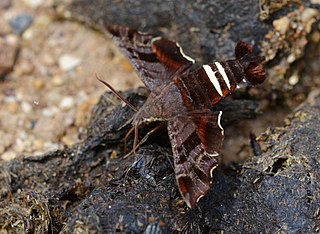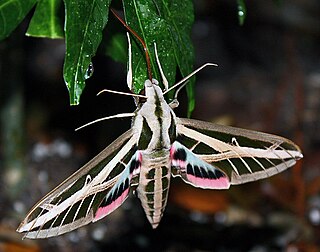
Eumorpha pandorus, the Pandora sphinx moth or Pandorus sphinx moth, is a North American moth in the family Sphingidae. The species was first described by Jacob Hübner in 1821.

Eumorpha labruscae, the gaudy sphinx, is a moth in the family Sphingidae.

Eumorpha is a genus of moths in the family Sphingidae. The genus is mostly found in North and South America.

Smerinthus jamaicensis, the twin-spotted sphinx, is a moth of the family Sphingidae. The species was first described by Dru Drury in 1773.

Eumorpha achemon, the Achemon sphinx, is a moth of the family Sphingidae. The species was first described by Dru Drury in 1773.

Eumorpha anchemolus, the anchemola sphinx moth, is a moth of the family Sphingidae. The species was first described by Pieter Cramer in 1780.

Eumorpha phorbas is a moth of the family Sphingidae.

Eumorpha satellitia, the satellite sphinx, is a moth of the family Sphingidae. The family was first described by Carl Linnaeus in 1771. It lives from Brazil and northern Argentina north through Central America, Mexico, and the West Indies to south Texas and southern Arizona.

Eumorpha triangulum is a moth of the family Sphingidae.

Eumorpha typhon, the Typhon sphinx, is a moth of the family Sphingidae. The species was first described by Johann Christoph Friedrich Klug in 1836.

Eumorpha vitis, known as the vine sphinx, is a moth of the family Sphingidae.

Proserpinus clarkiae, or Clark's sphinx, is a moth of the family Sphingidae. The species was first described by Jean Baptiste Boisduval in 1852. It is known from British Columbia and Washington south through California to Baja California, east to Idaho, Wyoming and Utah. The habitat consists of oak woodland and pine-oak woodland in foothills.

Amphion floridensis, the Nessus sphinx, is a day-flying moth of the family Sphingidae. The species was described by Pieter Cramer in 1777, and renamed in 1920. It is the only member of the genus Amphion erected by Jacob Hübner in 1819. It lives throughout the eastern United States and Canada and occasionally south into Mexico, and is one of the more commonly encountered day-flying moths in the region, easily recognized by the two bright-yellow bands across the abdomen.

Proserpinus vega, the vega sphinx moth, is a moth of the family Sphingidae. The species was first described by Harrison Gray Dyar Jr. in 1903. It is found from southern Arizona, New Mexico and Texas south into Mexico.

Eumorpha adamsi is a species of moth in the family Sphingidae. It was described by Walter Rothschild and Karl Jordan, in 1903, and is known from Venezuela, Brazil, Bolivia and Paraguay but is probably present throughout most of South America.

Eumorpha analis is a moth of the family Sphingidae.

Eumorpha drucei is a moth of the family Sphingidae. It is known from Ecuador.

Eumorpha fasciatus, the banded sphinx, is a moth of the family Sphingidae. The species was first described by Johann Heinrich Sulzer in 1776.

Eumorpha translineatus is a moth of the family Sphingidae.

Eumorpha strenua is a moth of the family Sphingidae. It is known from Haiti, Cuba and the Dominican Republic.



















